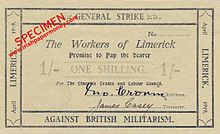Irish soviets
The labour movement in Ireland during the Irish War of Independence had been deeply affected by the events of the Dublin Lockout of 1913 as well as Bolshevik Revolution in Russia in 1917.
Led by Donegal union organiser and IRA Commander Peadar O'Donnell, the soviet was declared as part of a strike for better working conditions for the staff of the Monaghan Lunatic Asylum (as it was then known).
For two weeks all British troops were boycotted and the special strike committee organised the printing of their own money, control over food prices and the publishing of newspapers.
The following month on 15 May 1920, workers in County Limerick began seizing creameries belonging to the Cleeve Family Business, the primary one being located near the village of Knocklong.
The Cleeves were an Anglo-Canadian Unionist family committed to the British Empire, and a major business operator, employing over 3,000 workers across Ireland in dairy-related industries in addition to about 5,000 farmers.
A red flag was flown over the main building and a banner reading "KNOCKLONG SOVIET CREAMERY: WE MAKE BUTTER NOT PROFITS" was displayed.
At first, the Cleeves attempted to lay off workers at Knocklong under the auspices that a national general strike by ITGWU against handling British munitions had resulted in "a lack of work".
Thousands flocked to the City Hall where, before Amhrán na bhFiann was sung to close out the event, Union leaders sang the verses of The Red Flag while a crowd less familiar with the song piped in on the choruses.
On 27 April, an article headed " 'Soviet' Government in Waterford" graced the Guardian and asserted that a group of southern loyalists had given Bonar Law a ‘full account’ of events in the city.
[10] On 26 August 1921, the bakery and mills in Bruree, County Limerick (owned by the Cleeve Family) were occupied by almost all of its employees save the manager and a clerk.
Forcing the owners to the negotiation table at Liberty Hall in Dublin, Union officials claimed the soviet was able to drop prices, double sales and increase wages.
[11] Sinn Féin's Minister for Labour Countess Markievicz mediated the negotiations and it is alleged she threatened to send in IRA troops to the Bruree Soviet if they did not accept the outcome of the arbitration.
In response, workers seized control of the Cork Custom House, a red flag was flown and a soviet declared on 7 September.
[14] Between 1921 and 1923, other soviets were said to have arisen and seized North Cork railways, the mines at Arigna in County Roscommon (4 May 1921), the Drogheda Iron Foundry (September 1921), the quarry and the fishing boats at Castleconnell (November 1921), a coach builders in Tipperary as well as the local gas works (4 May 1922), a clothing factory in Dublin's Rathmines, sawmills in Killarney and Ballinacourtie (24 April 1922), the Ballingarry Coal Mines near Ballingarry, South Tipperary (24 April 1922), and the Waterford Gas Works (26 January 1923).
[2] The Civil War that erupted between those for and against the Anglo-Irish Treaty had seen Munster become a hotbed and base for the Anti-Treaty IRA forces, and thus a battleground to be fought over.
Extreme pressure was being placed on the fledgeling Irish Free State by both the British Government and the wider world to maintain a conservative order in Ireland.
When Free State forces entered any town that had a soviet, they would arrest the leaders and take down any symbols signalling defiance such as Red Flags.


